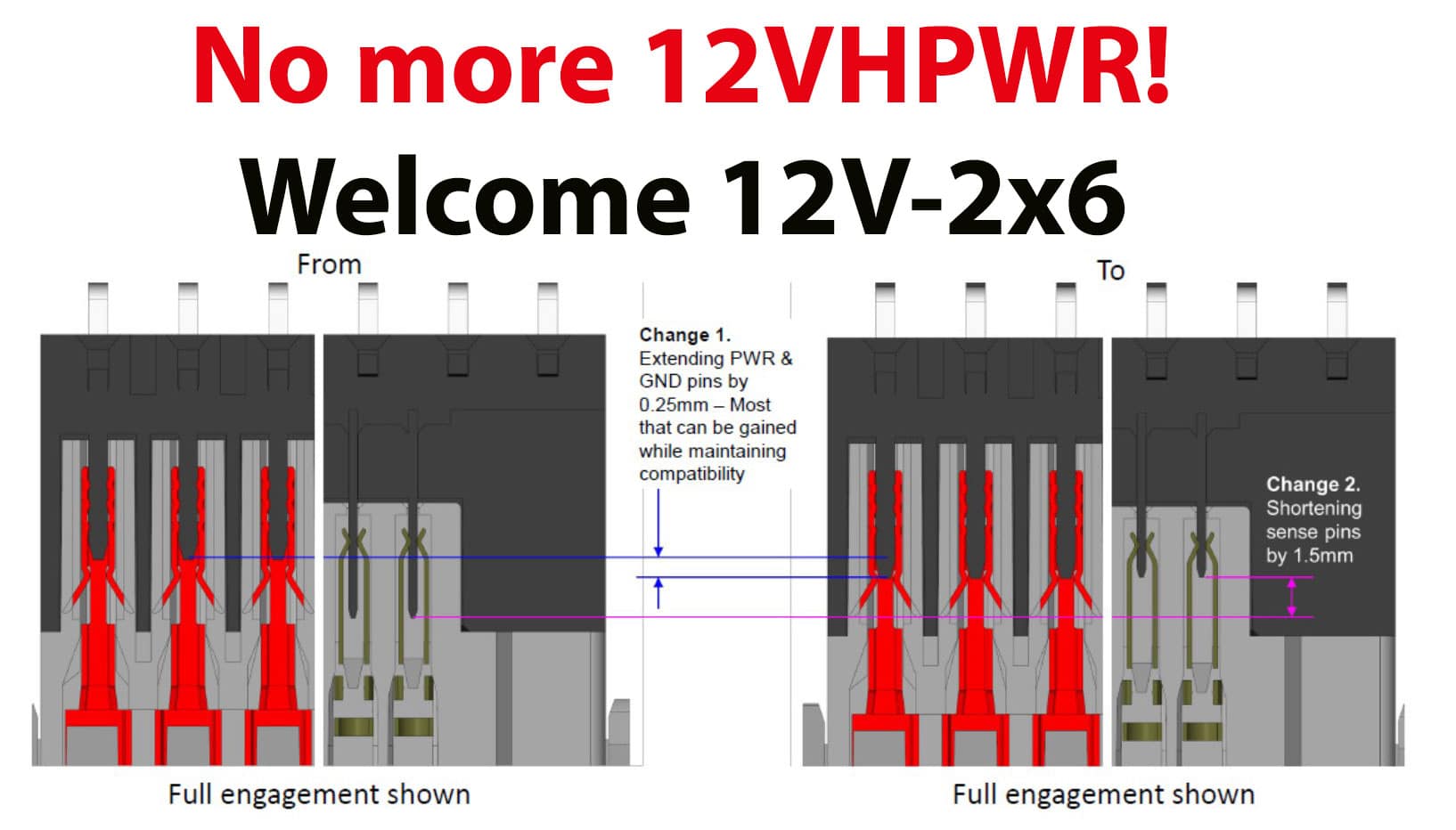It all started with NVIDIA’s 12-pin connector, then 12VHPWR (12+4 pin) was released and created lots of noise, and the time has come for the 12V-2×6 which I will show you in today’s article!
Before diving for good details, I must explain PCIe CEM. According to PCI-SIG, the organization responsible for developing and maintaining the standardized approach to peripheral component I/O data transfers, Card Electromechanical (CEM) connectors are one type of PCI-SIG-developed connector. They are by far the longest-standing PCIe form factors, with the first iteration delivered in 2000. CEM connectors play a significant role, as they are the connection between a motherboard, an add-in card (AIC), and a riser card.
The fresh CEM 5.1 specification replaces the pesky 12VHPWR connector with a new one called 12V-2×6, and in this article, in a short and brief way, I will help you understand what the new connector has to offer.
Change in sense pin receptacle
The opening for the sideband pins has been increased from 1.6mm x 9.3mm to 1.75mm x 9.4mm.
Change in terminal length:
- The depth of power terminals has been increased from 4.2mm to 4.45mm (6.6mm – 2.15)
- The depth of sense pin terminals has been decreased from 4mm to 2.5mm.
Comparison of terminal differences
If sense pins lose contact, power terminals should still be fully engaged. This ensures that there won’t be any increased resistance on the connector, which can lead to problems (aka melting connectors).
Another change is the 150W setting on the sense pins. In 12VHPWR, when both sense pins are open, the maximum power is 150W. In the new connector, the open-open scenario will change to 0 watts! For the 150W setting, Sense0 has to be shorted to Sense1.
The 12+4 pin cable won’t have any changes on the PSU side IF the manufacturers and brands avoided using 12+4 pin connections on the PSU’s modular panel (something that Corsair did, for example). If they used 12+4 sockets on the PSU side, then this change will also affect this side. According to my sources, there is backward compatibility, but this is something that is not 100% confirmed yet.






Im confused, I just bought a super flower leadex VIII 1300W. It is ATX 3.0 has normal pcie connectors on the modular side instead of utilizing a 12vhpwr on the modular side as well like some 3.0 PSU’s. Would this PSU be a good candidate for backwards compatibility since they arent using the single plug on the modular side? This is one of the first articles of yours that I cant wrap my head around lol.
On the modular panel, they can use whatever is convenient. What matters is the other end of the connector,, so it is a normal ATX v3.0 PSU. The cable doesn’t change but it is the same, with minor exceptions if you want to get a modded 600W set cable if your PSU has a lower setting. In any case, for me, having 2×8 pins is better than a single 12+4
I was about to buy a psu for a new build (be quiet straight power 1200w 12vhpwr)… Should i wait for the new 12v 2×6 connector to hit the market?
if you can wait for them, then yes.
Aris, What psu above 1000w is best for 4090 strix cards? I read your best picks and am confused by the nzxt pic when the fsp psu seems a better psu. Maybe something else you just looked at? Thanks, you guys are invaluable!
The NZXT C1200 is a good choice, although some users complained about coil whine, which seems to be a problem in the majority of ATX v3.0 PSUs.
You could also look at the XPG Cybercore II 1300.
Should have stuck with the dual plug on the cards that has worked for several years. I think Nvidia was trying to save money. Hense the reason for the singke dongle.
It’s less about money (we are talking about few dollars) it’s about space – 450 watt cards need 3x8pin plugs, if there will be 600W it will require 4x8pin plugs. this is space that needed to be allocated in the PC and on the cooler.
Corsair and Seasonic have 600Watt cables that only use dual 8-pin connections.
https://www.corsair.com/us/en/p/pc-components-accessories/cp-8920284/600w-pcie-5-0-12vhpwr-type-4-psu-power-cable-cp-8920284
https://seasonic.com/12vhpwr-cable#
8 pin power is capable of outputting 300 watts. In think the 3x 8 pin designed is to ensure 450 watts since a lot of power supplies have 2x 6+2 on one cable as a pig tail. And if you use that instead of getting 450watts you’ll only have 300watts and that will hurt the card since it will try to run without the right voltage. So it helps to prevent user error since most people don’t know this.
So, does this mean that the newly purchased ATX 3.0 psus with 12vhpwr will be obsolete if there is no backwards compatibility? I hope manufacturers give those new cables for free considering how this was a mishandling from the industry. Anyways, awesome reporting Aris!